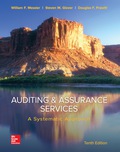
EBK AUDITING & ASSURANCE SERVICES: A SY
10th Edition
ISBN: 9781259293245
Author: Jr
Publisher: MCGRAW HILL BOOK COMPANY
expand_more
expand_more
format_list_bulleted
Concept explainers
Question
Chapter 17, Problem 17.18MCQ
To determine
Concept Introduction:
Going concern is one of the assumptions of the financial statement. According to this assumption, the entity is expected to run its business for the foreseeable future. Hence the financial statements are prepared assuming that the business will run at least for the next financial statement.
To choose: The procedure that can help the auditor to check the going concern assumption.
Expert Solution & Answer
Want to see the full answer?
Check out a sample textbook solution
Students have asked these similar questions
Need answer.
Solve plz now
Precious metal qn solve .
Chapter 17 Solutions
EBK AUDITING & ASSURANCE SERVICES: A SY
Ch. 17 - Prob. 17.1RQCh. 17 - Prob. 17.2RQCh. 17 - Prob. 17.3RQCh. 17 - Prob. 17.4RQCh. 17 - Prob. 17.5RQCh. 17 - Prob. 17.6RQCh. 17 - Prob. 17.7RQCh. 17 - Prob. 17.8RQCh. 17 - Prob. 17.9RQCh. 17 - Prob. 17.10RQ
Ch. 17 - Prob. 17.11RQCh. 17 - Prob. 17.12RQCh. 17 - Prob. 17.13MCQCh. 17 - Prob. 17.14MCQCh. 17 - Prob. 17.15MCQCh. 17 - Prob. 17.16MCQCh. 17 - Prob. 17.17MCQCh. 17 - Prob. 17.18MCQCh. 17 - Prob. 17.19MCQCh. 17 - Prob. 17.20MCQCh. 17 - Prob. 17.21MCQCh. 17 - Prob. 17.22PCh. 17 - Prob. 17.23PCh. 17 - Prob. 17.24PCh. 17 - Prob. 17.25PCh. 17 - Prob. 17.26PCh. 17 - Prob. 17.27PCh. 17 - Prob. 17.28P
Knowledge Booster
Learn more about
Need a deep-dive on the concept behind this application? Look no further. Learn more about this topic, finance and related others by exploring similar questions and additional content below.Similar questions
arrow_back_ios
SEE MORE QUESTIONS
arrow_forward_ios
Recommended textbooks for you
 Auditing: A Risk Based-Approach to Conducting a Q...AccountingISBN:9781305080577Author:Karla M Johnstone, Audrey A. Gramling, Larry E. RittenbergPublisher:South-Western College Pub
Auditing: A Risk Based-Approach to Conducting a Q...AccountingISBN:9781305080577Author:Karla M Johnstone, Audrey A. Gramling, Larry E. RittenbergPublisher:South-Western College Pub Auditing: A Risk Based-Approach (MindTap Course L...AccountingISBN:9781337619455Author:Karla M Johnstone, Audrey A. Gramling, Larry E. RittenbergPublisher:Cengage Learning
Auditing: A Risk Based-Approach (MindTap Course L...AccountingISBN:9781337619455Author:Karla M Johnstone, Audrey A. Gramling, Larry E. RittenbergPublisher:Cengage Learning

Auditing: A Risk Based-Approach to Conducting a Q...
Accounting
ISBN:9781305080577
Author:Karla M Johnstone, Audrey A. Gramling, Larry E. Rittenberg
Publisher:South-Western College Pub

Auditing: A Risk Based-Approach (MindTap Course L...
Accounting
ISBN:9781337619455
Author:Karla M Johnstone, Audrey A. Gramling, Larry E. Rittenberg
Publisher:Cengage Learning
